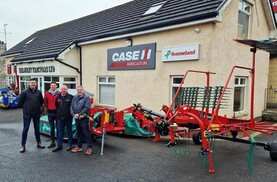Reseeding can be one of the most rewarding things that you will ever do on your farm, but conversely, getting a field ready to sow out can be one of the most soul- destroying jobs.
However, there is something about reseeding that gives me a lift. I always do a full plough reseed, and it’s that turning over of the soil that gives a real buzz.
It’s like starting a new chapter in your life. You’re burying the old stuff, in the hope of bringing new life and vitality to the surface.
Of course, if you do not manage your reseed, in the subsequent years you will soon find that it goes back to as bad as it was, or even worse. It’s not only managing it, but you must have enough suitable stock to make full use of the extra grass that you grow. Ultimately, there is no point in reseeding unless you can make it earn you more money.
Ploughing
I find that ploughing ground is like a history lesson, or a walk down memory lane. I have recently ploughed a field that has not been turned over for a long time (I can’t remember it ever being ploughed).
I haven’t touched it before because there is a steep hill running along one side, and the rest of it was very wet and needed a lot of drainage work.
With the good year we are having, I couldn’t find any more excuses not to tackle this field. We got all the drainage work done, but it was that dry I was wondering if I was wise. We then got it ploughed.
This has uncovered a lot of history and secrets.
It looks like this field was once split into at least seven different fields, and with some kind of lane or possible coach road on part of it.
It also looks like there had been a major drainage job done in the past. We discovered a lot of old drains. Some were still working, but some were damaged or blocked and needed repairing.
When I was a child, I remember my father doing work in this field, but I was too young to remember what exactly it was.
But by ploughing the field, I have got an insight into his endeavours. There was no shortage of drains, and they seemed to be well planned out, but they seemed to be a bit close to the top of the ground.
I’m not sure if this was because the machinery was not fit to dig any deeper. Or perhaps maybe the ground has dried out around the drains, and they have risen closer to the surface.
All this history was nice to recall, and my sons have had an insight into their grandfather’s work.
Stones
The other thing that the plough has turned up is a mass of stones. Not many really big ones, but lots of medium-sized examples, ones that you can just about lift into the link box.
I hate wasting things and given the price I had to pay for drainage stones, I didn’t want to just dump these stones. So, I have decided to make a lane down the side of the field.
We have put in some long, hard days gathering stones but at least they are being put to good use, and when we get the reseeding finished we will have a good lane to help improve grazing management.
There are times that I think that I should have tried some easier way to reseed this field, perhaps just burning it off, and sowing it with grass seed. But the ploughing helps with drainage, and the field needed to be levelled. The added bonus is the new lane.
Reseeding is challenging work and expensive, but it can be rewarding in various different ways.






 This is a subscriber-only article
This is a subscriber-only article












SHARING OPTIONS: